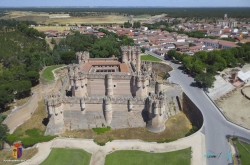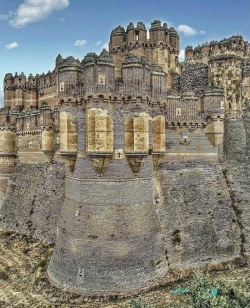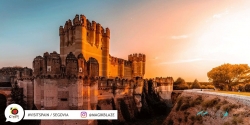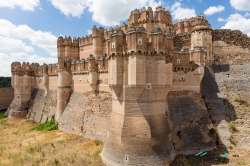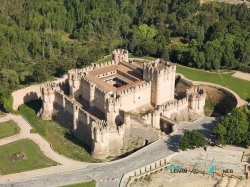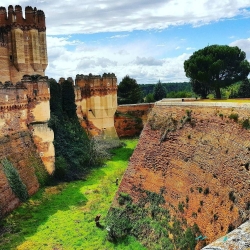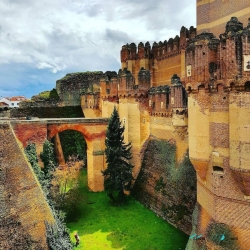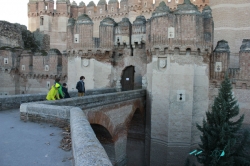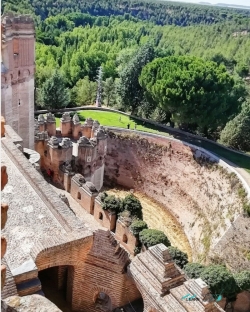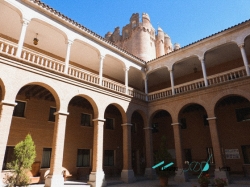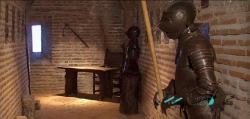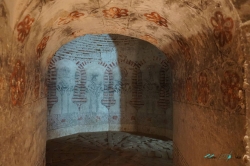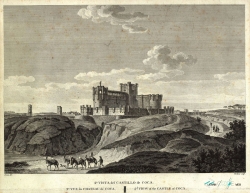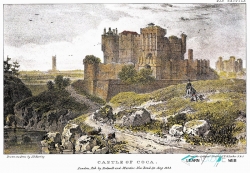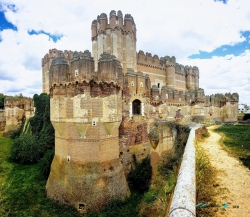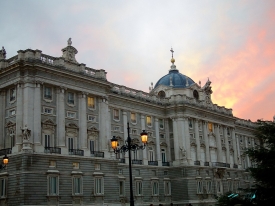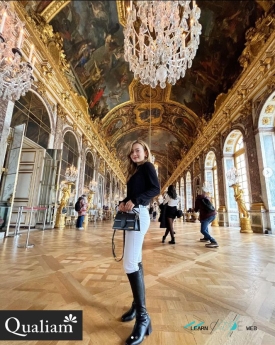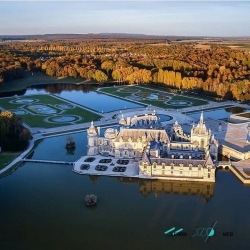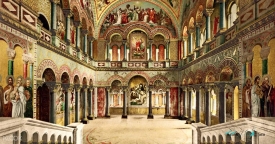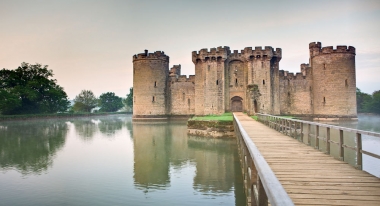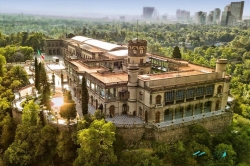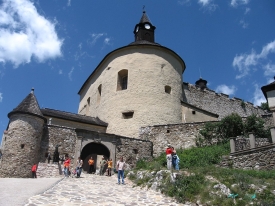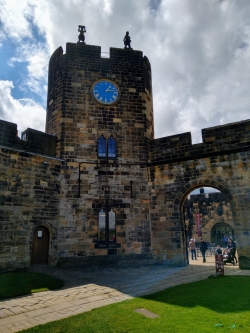ABOUT Castle of Coca
Coca Castle: A Treasure of Mudejar Architecture in the Heart of Spain
El Castillo is majestically located in the municipality of Coca, in central Spain. Built in the 15th century, this castle is an impressive testimony to the fusion between Arab-Muslim influence and Gothic architecture. In this article, we will explore the history and beauty of this unique castle, which has left an indelible mark on Spanish history and culture.
The Castillo de Coca stands on the outskirts of the charming town of Coca, some 45 kilometers north of Segovia, in a strategic position at the top of a steep esplanade. Its imposing presence looks out over the meander of the Voltoya River, a tributary of the Eresma River. Unlike many Spanish castles that sit on top of hills, Castillo de Coca has been built in a unique location that makes it a singular piece of architecture.
Coca, in addition to being home to this emblematic castle, is also the birthplace of the Roman Emperor Theodosius I. The site has been inhabited since ancient times, dating back to the 2nd century BC, when the Arevaci settled in the region. The castle, surrounded by a wide and deep moat, represents an outstanding example of defensive architecture.
The Castillo de Coca was erected under the watchful supervision of an Arab architect and engineer. During the Middle Ages, these Moorish engineers were entrusted with the construction of large buildings, and they were known as "Alarife", experts in the art of construction. For the most part, the castle was built using specially hardened bricks, designed to withstand enemy sieges.
The uniqueness of the bricks used lies in their arrangement, which together with the mortar, creates a distinctive pattern in the castle. This geometric pattern is a distinctive feature of the Classical Mudejar style, which combines influences from Muslim Moorish architecture with Christian Gothic elements. In addition to brick, limestone and plaster were used in the balistrarias and embrasures, as well as in the decoration of the columns in the courtyard and the majestic keep.
Coca Castle has gained well-deserved international fame, and its beauty has been immortalized in a model found in the Mudejar theme park. In addition, a 1:25 scale replica stands in the Minimundus miniatures park in Klagenfurt, Austria, highlighting its importance and appreciation in the world of architecture and history.
Coca Castle is much more than a medieval fortress; it is a living testimony of the rich history of Spain and the influence of different cultures on its architecture. This unique castle, with its Mudejar brickwork and Gothic elements, remains an important landmark in the heart of Spain and a lasting testament to the skill and vision of the architects and builders of the Middle Ages. His legacy transcends borders, gaining international recognition and continuing to inspire those who are privileged to visit.
El Castillo is majestically located in the municipality of Coca, in central Spain. Built in the 15th century, this castle is an impressive testimony to the fusion between Arab-Muslim influence and Gothic architecture. In this article, we will explore the history and beauty of this unique castle, which has left an indelible mark on Spanish history and culture.
History and Location
The Castillo de Coca stands on the outskirts of the charming town of Coca, some 45 kilometers north of Segovia, in a strategic position at the top of a steep esplanade. Its imposing presence looks out over the meander of the Voltoya River, a tributary of the Eresma River. Unlike many Spanish castles that sit on top of hills, Castillo de Coca has been built in a unique location that makes it a singular piece of architecture.
Coca, in addition to being home to this emblematic castle, is also the birthplace of the Roman Emperor Theodosius I. The site has been inhabited since ancient times, dating back to the 2nd century BC, when the Arevaci settled in the region. The castle, surrounded by a wide and deep moat, represents an outstanding example of defensive architecture.
The Mudejar Influence and the Art of Arab Construction
The Castillo de Coca was erected under the watchful supervision of an Arab architect and engineer. During the Middle Ages, these Moorish engineers were entrusted with the construction of large buildings, and they were known as "Alarife", experts in the art of construction. For the most part, the castle was built using specially hardened bricks, designed to withstand enemy sieges.
The uniqueness of the bricks used lies in their arrangement, which together with the mortar, creates a distinctive pattern in the castle. This geometric pattern is a distinctive feature of the Classical Mudejar style, which combines influences from Muslim Moorish architecture with Christian Gothic elements. In addition to brick, limestone and plaster were used in the balistrarias and embrasures, as well as in the decoration of the columns in the courtyard and the majestic keep.
Legacy and International Recognition
Coca Castle has gained well-deserved international fame, and its beauty has been immortalized in a model found in the Mudejar theme park. In addition, a 1:25 scale replica stands in the Minimundus miniatures park in Klagenfurt, Austria, highlighting its importance and appreciation in the world of architecture and history.
Coca Castle is much more than a medieval fortress; it is a living testimony of the rich history of Spain and the influence of different cultures on its architecture. This unique castle, with its Mudejar brickwork and Gothic elements, remains an important landmark in the heart of Spain and a lasting testament to the skill and vision of the architects and builders of the Middle Ages. His legacy transcends borders, gaining international recognition and continuing to inspire those who are privileged to visit.
The Best Pictures of Castle of Coca
Videos of Castle of Coca


![[4k]](https://i1.ytimg.com/vi/aTpM4Q-j46k/mqdefault.jpg)




